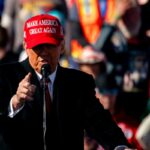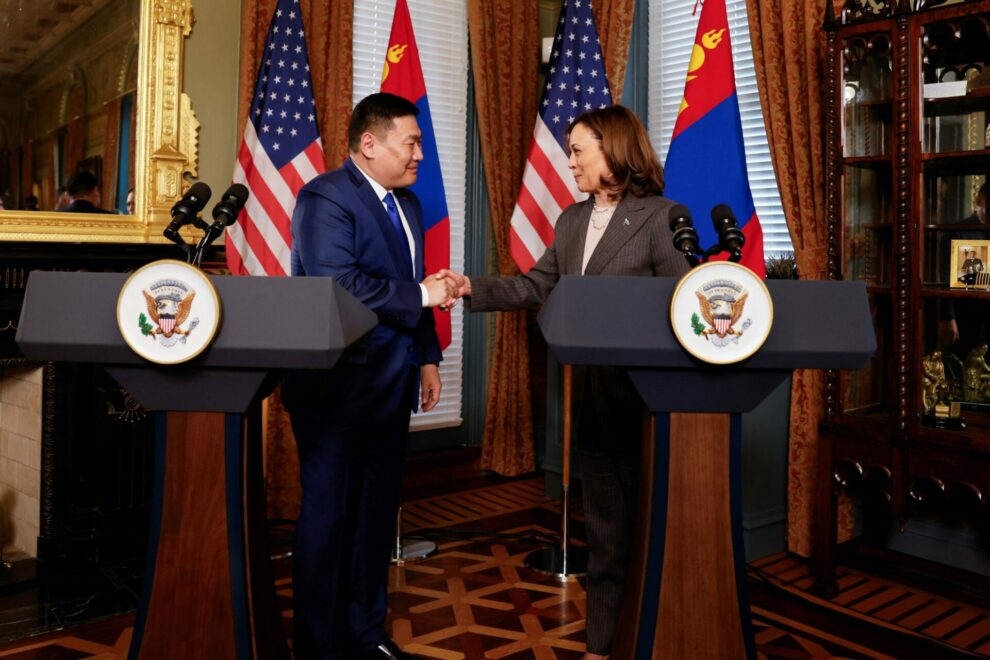Mongolian Prime Minister Luvsannamsrain Oyun-Erdene visited Washington DC on the invitation of US Vice President Kamala Harris in August 2023. The high-level bilateral meeting envisages a deepening of US–Mongolia economic relations in diverse sectors, such as critical minerals, aviation and trade.
As global powers continue to race for partnerships and resources, Mongolia’s natural resources are valuable and critical for its national economy. The incumbent government’s strategy to attract investment revolves around capitalising on the critical minerals with immediate neighbours Russia and China, as well as ‘third neighbour’ partners like the United States, South Korea France, and other developed nations.
The United States and Mongolia established a strategic partnership in 2019 during the administrations of former presidents Donald Trump and Battulga Khaltmaa. President Joe Biden’s administration further committed to strengthening the United States’ long-term position in the Indo-Pacific, which includes Mongolia.
The US Indo-Pacific Strategy and Mongolia’s third neighbour foreign policy provide a robust foundation for the two countries to strengthen Mongolia’s democratic institutions, economic diversity and civil society. The Biden administration’s courting of Ulaanbaatar indicates a growing US interest in boosting economic ties, amid its tensions with Moscow and Beijing.
The high-level meetings between Mongolian and US leaders provide the working mechanism of Mongolia’s third neighbour foreign policy. The changing geopolitical environment in Northeast Asia remains a challenge for Ulaanbaatar’s economic endeavours. Collegial relationships with global partners — including immediate neighbours Russia and China, and the United States — are the cornerstone of Ulaanbaatar’s foreign policy. So Mongolia must be vigilant, stable and flexible with its third neighbour’s pursuits.
Given Mongolia’s geographical constraint of being landlocked between two major US adversaries — Russia and China — strengthening strategic partnership with Washington requires flexibility and a systematic diplomatic approach to accelerate economic collaboration.
In 2018, before establishing the strategic partnership, the US Congress proposed the Mongolia Third Neighbor Trade Act. The bill was reintroduced to Congress in 2019 and 2021, adding to delays. If approved, Mongolia’s high-quality cashmere and textiles could be exported to the United States duty-free.
Another effort to improve Mongolia’s legal environment for trade is the signing of the US–Mongolia Transparency Agreement in 2017. This 2017 trade agreement represented the first stand-alone agreement on international trade and investment transparency signed by the United States. In the past, the United States has only ever negotiated transparency commitments as a part of broader agreements. Negotiating a stand-alone agreement with Mongolia concretely builds on cooperation between the United States and Mongolia and makes it possible for economic activities to accelerate.
The bilateral trading relationship continues to flourish, with Mongolia’s exports to the United States increasing at an annualised rate of 1.84 per cent between 1995 and 2021. Even so, Washington still requires more action from the Mongolian government.
In January 2023, US Ambassador to Mongolia Richard Buangan stated his concern to the American Chamber of Commerce in Mongolia on the country’s opaque legislative processes and investment climate that remains ‘unattractive for investors and challenging for importers and exporters’. In an effort to deepen US–Mongolia economic ties, the US Under Secretary of State for Economic Growth, Energy and the Environment Jose W Fernandez met with senior government officials and other stakeholders in Ulaanbaatar in June 2023.
On a later visit to Washington, Prime Minister Oyun-Erdene also signed the US–Mongolia Open Skies Agreement into implementation. The US Department of Transportation noted that ‘the Agreement will facilitate greater air connectivity between the United States and Mongolia and will provide the legal framework for nonstop passenger flights’. Mongolia is now the 132nd US Open Skies partner. In addition, Mongolia received its first Boeing 787 Dreamliner in August 2023 and will be starting a direct flight from San Francisco to Ulaanbaatar.
But Mongolia will still need to strengthen and accelerate economic ties with Moscow and Beijing via bilateral and trilateral channels, such as the Russia–Mongolia–China Economic Corridor. Other trilateral meetings also serve as an important economic gateway, such as the US–Mongolia–South Korea or the US–Mongolia–Japan partnerships.
From a geopolitical standpoint, as the Russia–Ukraine war and US–China trade tensions continue to destabilise the region and the world, small states like Mongolia often face a conundrum. Maintaining a balanced approach is necessary for continuing Mongolia’s historical connectivity of comprehensive strategic partnerships with Moscow and Beijing.
In the short-to-medium term, Beijing will remain a strong economic partner for Mongolia as an immediate neighbour and a top investment source for Mongolian copper ore, coal briquettes and iron ore. But Mongolia is now a candidate for the Minerals Security Partnership, an initiative with 14 countries — mostly Western — that aims to bolster sustainable investment in critical minerals’ mining, processing and recycling.
Mongolia must ensure that its foreign policy remains flexible and diversified to support its economic and social development.
Source: East Asia Forum















